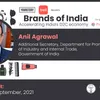[Brands of India] How video and vernacular languages can be leveraged to grow your brand
At YourStory's Brands of India, Bimal Kartheek Rebba, Co-founder, Trell, spoke about how brands can use video content and vernacular language to leverage a new user base in Tier II and III.
A whopping 73 percent of India’s digital users consume video content in vernacular languages, but only four percent of the content created online is in regional languages.
However, the Tier II market comprises 210 million video and mobile-first users, with a disposable income of $300 million.
“Therefore, why not use video to make your brand popular among a new userbase,” asked Bimal Kartheek Rebba, Co-founder, Trell, to the attendees during a Masterclass at YourStory Brands' of India launch event.
Bengaluru-based social commerce platform — founded in 2016 — has over 50 million monthly active users. It hosts over 600 brands on its platform from categories, including beauty, personal care, health and wellness, men’s grooming, etc.
"We understand insights brands can use — social, mobile-first videos, and language — to scale India as a market," said Bimal.

Trell Founders: From left - Pulkit Agarwal, Prashant Sachan, Arun Lodhi, Bimal Kartheek Rebba
Targeting the Tier II and III markets
Monetisable market
Bimal highlighted that two out of three users in India are still non-online product shoppers; close to 66 percent don’t buy products online.
And, the reasons for the low turnout are — lack of trust, language barrier, and not being aware of the brand.
"However, these vernacular language Indian users are highly monetisable and have 2X spending power as compared to English monetisable internet users," he said.
Since most of these users are video content consumers, brand content should be tailored to suit this userbase.
Tech-savvy users
"Homegrown D2C brands are offering high-quality products — designed keeping Indian audiences in mind, in the lifestyle segment — at affordable prices. It is a perfect model for a diverse Indian audience. At present, the target is the 110 million online shoppers of India I, but there are 734 million internet users, of which 536 million are Indian language content consumers, and 500 million video content consumers," said Bimal.
The Indian language content consumers spend two or more hours on social media each day. While they engage online, they don't transact much because of trust issues. However, they experiment in trying new brands and want to know more about them in their native languages.
"Of these, fashion, personal care, beauty and wellness categories have witnessed stupendous volume growth of over 95 percent in Q4 2020 — the highest growth in the industry — owing to the increasing adoption from Tier-II cities and beyond," Bimal said, adding these are purely peer-driven and have high trust as a leveller.
"They are okay to wait for the product, but they aren't okay to buy from an unknown source," Bimal highlighted.
Invest in voice and vernacular, video, and social shopping
"Invest in these three avenues to improvise your content, improve your user experience, and educate your consumers about your products and services through trusted sources," explained Bimal.
There are 536 million vernacular language content users. Tamil has the highest internet adoption, followed by Hindi (21 percent) and Bengali (20 percent). As this reaches 30 percent, they will become huge captive markets.
In terms of video, of the 536 million Indian language content consumers, close to 300 million watch video content, which means, two out of three online users consume content on their mobile phones. Brands need to use this lever to build for scale, Bimal added.
For the social shopping landscape, a cumulation of voice, vernacular, and video is required that can help sellers to reach a user base of a whopping 400 million. It also makes the shopping journey simpler with one single click.
"Current ecommerce sites do not allow giving the product details in a personalised way as video can," added Bimal.
Building trust through influencers
Despite having the best products and pricing, brands struggle to reach their potential consumers because users from markets beyond Tier II are not clear about what they want.
"This has led to creating opportunities for peer-led/impulse purchases, which means low repeat purchases," Bimal said. He added brands need to keep these three factors in mind:
a. Focus on inclusivity and diversity of languages to create solutions for emerging India
b. Create multilingual strategies to accommodate users who have a clear preference for the consumption of vernacular online content
c. Partner with regional content creators and influencers to create language-based content, which can build trust among users.
"In the next five years, growth of vernacular video consumption will create many opportunities for multiple businesses and diversify content creation and commerce in India — creating over 50 million self-sustainable micro-entrepreneurs and over 3000 emerging D2C brands," he added.
Brands of India is a YourStory initiative to catalyse the growth of India's D2C economy. It will bring together D2C ecosystem stakeholders, including brand builders, D2C startups, investors, corporates, and policymakers, to discover, build and help daring entrepreneurs create an additional 500 Brands of India in the next three years.
To know more about this initiative and the D2C ecosystem, visit brandsofindia.yourstory.com.
Edited by Suman Singh


![[Brands of India] How video and vernacular languages can be leveraged to grow your brand](https://images.yourstory.com/cs/2/a9efa9c02dd911e9adc52d913c55075e/BOIBimalKartheek-1631866314071.png?mode=crop&crop=faces&ar=2%3A1&format=auto&w=1920&q=75)







